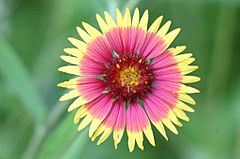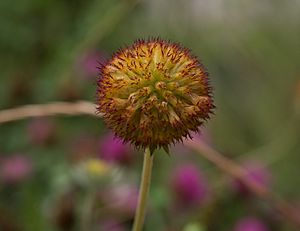Firewheel facts for kids
Quick facts for kids Gaillardia pulchella |
|
|---|---|
 |
|
| Indian Blanket | |
| Scientific classification | |
| Kingdom: | |
| Division: | |
| Class: | |
| Order: | |
| Family: | |
| Genus: | |
| Species: |
G. pulchella
|
| Binomial name | |
| Gaillardia pulchella Foug., 1788
|
|
The Indian blanket (Gaillardia pulchella) is a beautiful flowering plant. It is also known as the firewheel flower. This plant usually lives for only one year, making it an annual plant. It grows naturally in the central United States. You can easily find it growing across the southeastern parts of the country.
Indian blanket flowers are very colorful. They have bright red petals with a yellow edge. These flowers are a bit smaller than a similar plant called Gaillardia aristata. But the Indian blanket is super tough! It can handle very dry weather and even salty soil. This is why it grows well along sandy coastal areas.
How Indian Blanket Plants Grow
The Indian blanket plant has a stem that branches out. It is usually hairy and stands upright. This stem can grow up to 60 centimeters (about 2 feet) tall. The leaves grow on opposite sides of the stem. Most of them are found near the bottom of the plant. They are about 4 to 8 centimeters long. Their edges can be smooth, slightly toothed, or even deeply cut.
The flowers look like pinwheels or daisies. They are about 4 to 6 centimeters wide. Their colors are very bright, with shades of red, orange, and yellow. The center part of the flower head is often more reddish-purple. The outer petals, called ray florets, are usually yellow. In some types, almost the whole flower is red. Only the very tips of the petals might be yellow.
These plants can bloom for a long time. In some places, they flower almost all year. But usually, you will see them blooming from summer to early fall. After the flower fades, it produces a small fruit. This fruit is called an achene.
Amazing Plant Features
The Indian blanket is a very strong plant. It is not picky about the type of soil it grows in. However, it does best in sandy soil that drains water well. This plant loves dry, hot weather and needs lots of sunshine. You can often see its bright flowers covering fields. They also line the sides of highways for many miles during summer and fall.
Honeybees really like these flowers. They collect nectar from them to make honey. The honey made from Indian blanket flowers is dark reddish-amber. It has a buttery taste. If you grow these flowers in a garden, you can help them bloom more. Just remove the old, faded flowers. This is called "deadheading." The plant also drops its own seeds easily. This means new plants will often grow on their own.
Images for kids



